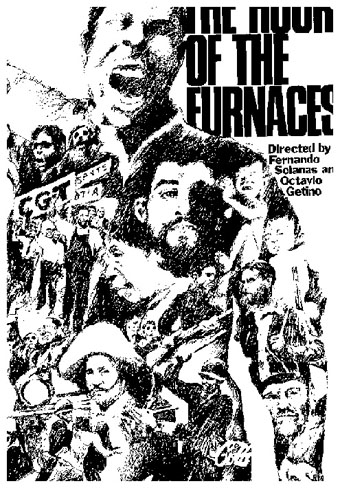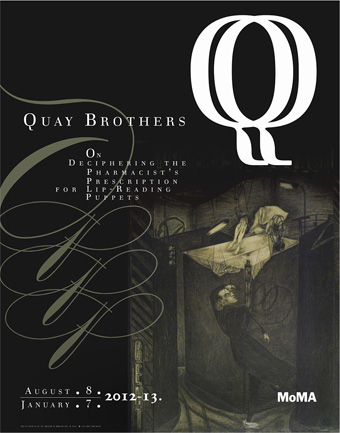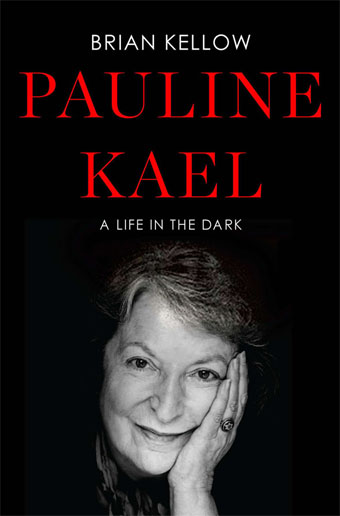The biggest news of this past week has to be Abbas Kiarostami‘s claim in a conversation with Indiewire‘s Eric Kohn that Jafar Panahi has completed a new feature film, despite facing a 20-year ban on filmmaking and a six-year jail sentence imposed by Iranian authorities in 2010: “After his sentencing he made the film that played at Cannes [This Is Not a Film], and since then he has made another. I guess it will be shown at another festival. So he is making films in Iran. I don’t know why, but that’s a reality people cannot deal with.”
Otherwise, the bulk of today’s news update is taken up with a range of new Sunday-busting issues, beginning with word from Catherine Grant that there’s a new Jump Cut out. Issue 54’s a monster, as they all are. Catherine “hasn’t digested the entire issue yet, but so far particularly likes the dossier on Third Cinema filmmaker Jorge Sanjinés, Ian Murphy‘s article on two films by Claire Denis, and Diane Waldman‘s very thoughtful review of Vicki Callahan’s important edited collection, Reclaiming the Archive: Feminism and Film History together with Suzanne Leonard’s great study of Fatal Attraction.”
In the same entry, Catherine also posts a tribute to Octavio Getino, “best known for co-founding, along with Fernando Solanas, the Grupo Cine Liberación as well as for elaborating with Solanas and others the notion of Third Cinema.” Getino, who died this past Monday, also co-directed The Hour of the Furnaces (1968) with Solanas. If that title doesn’t ring a bell, please do see the video essay Nicole Brenez and Kevin B. Lee as well as Nicole Brenez‘s piece for Sight & Sound.
I’ve only just now come across desistfilm, a multi-lingual journal out of Peru, but the second issue is definitely worth a good chunk of your Sunday. For orientation’s sake, you might start with the Top 50 lists submitted by members of the editorial committee, Adrian Martin among them: “Amusingly enough, this opportunity to beef up my 2012 list for the Sight & Sound poll allows me to unleash my old-school-cinephile side, which I repressed for the sake of a humble intervention into contemporary canon-formation.” He’s also got a piece on Kira Muratova’s Passions (1994), while Claudia Siefen offers “Views and Thoughts of the Cinematic with Ludwig Wittgenstein,” and John A. Riley explores the filmography of Frank Zappa. Interviews: José Sarmiento Hinojosa with Juhui Kwon, Joana Preiss, and Christelle Lheureux, and Jan Philippe V. Carpio with Lav Diaz.
Plus, the staff reviews a round of Japanese New Wave films: Jan Philippe V. Carpio on Susumu Hani’s Nanami: The Inferno of First Love (1968), Vassilis Economou on Kijû Yoshida’s Coup d’Etat (1973) and Nagisa Oshima’s Tokyo Sense Sengo Hiwa (1970), Sarah Nichols on Yukio Mishima’s Patriotism (1966) and Seijun Suzuki‘s Tokyo Drifter (1966), Lauren Bliss on Masao Adachi’s A Gushing Prayer (1971), John A. Riley on Kazuo Hara’s Extreme Private Eros (1974) and Seijun Suzuki’s Branded to Kill (1967), and Wiwat Lertwiwatwongsa on Katsu Kanai’s The Kingdom (1973) and Masao Adachi’s A.K.A. Serial Killer (1969). On a related note, the dates for MoMA’s exhibition Tokyo 1955–1970: A New Avant-Garde are November 18 through February 25.
Speaking of Japan, there are three new pieces up at Midnight Eye: Jeff Hammond reports on the fourth edition of the Okinawa International Movie Festival, Mike Dillon reviews Isabel Coixet’s Map of the Sounds of Tokyo (2009), and Tom Mes reviews Kazuhiko Yamaguchi’s Wandering Ginza Butterfly (1972).
Quay Brothers: On Deciphering the Pharmacist’s Prescription for Lip-Reading Puppets, on view at MoMA through January 7, “is a once-in-a-lifetime show not to be missed,” writes Thyrza Nichols Goodeve. “You pull open the door to the entrance and transmogrify from mundane human into what can only be called the condition of Quay.” Also in the new Brooklyn Rail: Rachael Rakes on Ben Rivers’s Two Years at Sea (more on that one soon), Leo Goldsmith on Leos Carax’s Holy Motors, Christina Gerhardt on Christian Petzold‘s Barbara, Paul Felten on David Cronenberg’s Cosmopolis, and Michèle Gerber Klein‘s quick profile of Shirin Neshat.
New at the Chiseler: John Strausbaugh on screenwriter Samuel Ornitz’s Haunch, Paunch and Jowl (1923), “a semi-autobiographical novel that’s still read for its marvelous details on the lives of Lower East Side Jews at the turn of the 20th century,” Imogen Smith on Jean Renoir’s Toni (1935), and Jim Knipfel on the varied career of “actor, six-foot-five half-breed Glenn Strange.”
More reading. “It seems to me that in 1940s Hollywood, directors came to a new consciousness of the long take,” writes David Bordwell. “Preminger, Ophuls, Sturges, and Welles became famous for their sustained shots, and even Hitchcock, a long-time proponent of editing, switched sides, making some of the longest-take films of the era. Sometimes an action scene might be played out in one flamboyant take, as in The Killers and Gun Crazy. It does seem that these big boys appearing to compete to see how long they could hold their shots and how complicated they could make them. One scene in Welles’s Macbeth runs a full camera reel, or about ten minutes; Hitchcock’s Rope contains only eleven shots. Yet I don’t think that macho showoffishness or competition can completely explain the urge to shoot long takes. Watching the Vancouver Dragons and Tigers series leads me to consider some other options.”
Peter Conrad reviews David Thomson’s The Big Screen: “As Thomson’s wayward and digressive history nears the present, it strays into alarming terrain. He abhors TV (although he considers the old-time BBC to have been ‘the best film studio there ever was’) because its screens hypnotize us without demanding either concentration or empathy: like electricity, it is a ‘service’ we switch on, and what it provides is not light but ‘a safeguard against disorder and fear,’ enabling us to whistle in the dark. It has led to the frenzied fragmentation of YouTube, where you’re only asked to look at bits or clips, ‘the debris from an explosion in the culture.’ We too have been atomized: film bifurcated reality, turned a person into an image. Everyone, whether or not they live in Essex or the Big Brother house, now stars in their own imaginary movie, or at least their personal sitcom. This, Thomson concludes, is ‘the alienation that befalls people who live on or through screens.'”
Also in the Guardian, Laura Cumming: “The art shortlisted for the 2012 Turner prize is vivid, intelligent and original, with one dismal exception. And just for once the same can be said of the exhibition itself…. Elizabeth Price has a video work, The Woolworths Choir of 1979, that builds so fast and hard it fairly overpowers the viewer…. Luke Fowler‘s film about RD Laing and the anti-psychiatry movement is, by contrast, long, slow, diffuse and elusive. It is also absolutely compelling.” More from Charles Darwent in the Independent.
At Cinespect, Brian Doan reviews Brian Kellow’s Pauline Kael: A Life in the Dark and the Library of America collection The Age of Movies: Selected Writings of Pauline Kael.
In other news. “The BFI Reuben Library is making the paper archive of director Ken Loach accessible to the public,” reported Wendy Russell on Wednesday. “The collection will be available in stages as the cataloguing work continues, with the first part ready to view from next week.” Also at the BFI: Ashley Clark on Paul Auster and his “deep relationship with cinema.” That one’s rather short, and if you’d rather go long with Auster, turn to Stacey Kors‘s cover story for Columbia.
Berkeley. An Army of Phantoms: American Cinema and the Cold War, a series at the Pacific Film Archive running through October 27, is, of course, based on the book by J. Hoberman; blook runs an excerpt. Related viewing (94’55”). Via Ray Pride, J. Hoberman’s keynote address at this year’s Milwaukee Film Festival on the future of film criticism.
New York. “It’s Such a Beautiful Day (2012), is currently in limited release and affirms [Don] Hertzfeldt as a true virtuoso, constructing an emotional narrative of existential meditation from swaths of banal occurrences, nightmarish hallucinations and devastatingly funny memories,” writes Kurt Shulenberger in MUBI’s Notebook. More from Joseph Jon Lanthier (Slant, 3/4). Beautiful Day is at the IFC Center through Tuesday and then moves around the country through the rest of the year.
Tomorrow at Light Industry, Hito Steyerl introduces a screening of Esfir Shub‘s The Fall of the Romanov Dynasty (1927).
Cambridge. The Mysteries of Michelangelo Antonioni, “an extensive retrospective of the feature-length and short masterworks,” is on at the Harvard Film Archive through November 18.
Chicago. A generous sampling of work by Werner Schroeter is screening at Facets Cinematheque, and Reader offers several capsule reviews and Ben Sachs‘s diary-like entry on watching these films.
Boston. “Now in its sixth year, the Boston Palestine Film Festival screens films that show a little-seen world in the hopes of promoting understanding, reconciliation, and peace,” writes the Phoenix‘s Peter Keough. Through Saturday.
London. Celluloid Liberation Front for Indiewire: “The ghosts of the past happen to be the subject matter of John Akomfrah’s Hauntologies, his new exhibit that [opened Friday] at the Carroll / Fletcher gallery. Born in Ghana, Akomfrah immigrated to England where he studied art before founding the Black Audio Film Collective. He has consistently treated the past as a science fiction gateway through which to analyze the present.” Through November 8.
In the works. “David O. Russell wastes no time,” writes Sophia Savage at Thompson on Hollywood. “After winning Toronto‘s Audience Award with Silver Linings Playbook (Oscars, here it comes), he’s lined up the film’s star, Bradley Cooper, The Fighter‘s Amy Adams and Christian Bale, and Jeremy Renner for a new untitled ensemble project.” And she’s got a synopsis.
Obit. Claude Pinoteau, primarily known for directing La boum and La boum 2, introducing us to Sophie Marceau, passed away on Friday. He was 87. “He was a brother,” tweets Claude Lelouch.
More Sunday browsing? See the Film Doctor and Steve Greene (Criticwire).
For news and tips throughout the day every day, follow @KeyframeDaily on Twitter and/or the RSS feed. Get Keyframe Daily in your inbox by signing in at fandor.com/daily.






